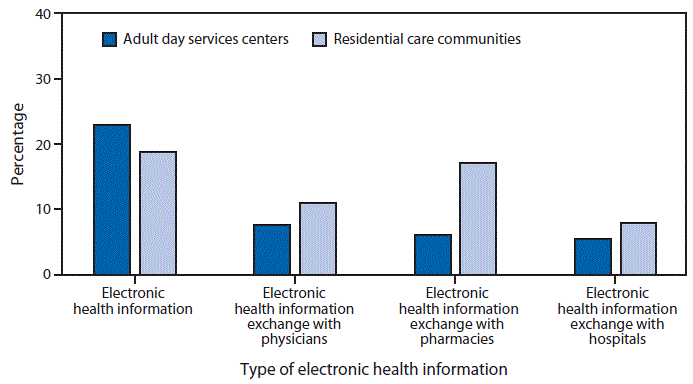QuickStats: Percentage of Long-Term Care Services Providers* That Use Electronic Health Records† and Have a Computerized System for Electronic Health Information Exchange,§ by Provider Sector and Type of Electronic Health Information — United States, 2014¶
Please note: An erratum has been published for this article. To view the erratum, please click here.

* Long-term care services providers included 1) adult day services centers that were state-regulated or participated in Medicaid and self-identified as adult day care, adult day services, or adult day health services centers and 2) residential care communities that were state-regulated, had four or more beds, and provided room and board with at least two meals a day, around-the-clock onsite supervision, and help with personal care such as bathing and dressing or health-related services such as medication management. Residential care communities licensed to exclusively serve the mentally ill or the intellectually disabled/developmentally disabled populations were excluded.
† Respondents were asked, "An electronic health record is a computerized version of the resident's/participant's health and personal information used in the management of the resident's/participant's health care. Other than for accounting or billing purposes, does this residential care community/adult day services center use electronic health records?"
§ Respondents were asked, "Does this residential care community's/adult day services center's computerized system support electronic health information exchange with each of the following providers (do not include faxing)? a. physician, b. pharmacy, c. hospital."
¶ Adult day services centers and residential care communities with missing data were excluded.
In 2014, nearly one fourth (23%) of adult day services centers used electronic health records (EHRs), and fewer than 10% had a computerized system that supported electronic health information exchange with physicians (8%), pharmacies (6%), and hospitals (6%). About one fifth (19%) of residential care communities used EHRs, and 11% had a computerized system that supported electronic health information exchange with physicians, 17% with pharmacies, and 8% with hospitals.
Source: National Study of Long-Term Care Providers, 2014. Available at http://www.cdc.gov/nchs/nsltcp/nsltcp_rdc.htm.
Reported by: Vincent Rome, MPH, vrome@cdc.gov, 301-458-4466; Christine Caffrey, PhD; Eunice Park-Lee, PhD.
Alternate Text: In 2014, nearly one fourth (23%) of adult day services centers used electronic health records (EHRs), and fewer than 10% had a computerized system that supported electronic health information exchange with physicians (8%), pharmacies (6%), and hospitals (6%). Approximately one fifth (19%) of residential care communities used EHRs, and 11% had a computerized system that supported electronic health information exchange with physicians, 17% with pharmacies, and 8% with hospitals.
Use of trade names and commercial sources is for identification only and does not imply endorsement by the U.S. Department of
Health and Human Services.
References to non-CDC sites on the Internet are
provided as a service to MMWR readers and do not constitute or imply
endorsement of these organizations or their programs by CDC or the U.S.
Department of Health and Human Services. CDC is not responsible for the content
of pages found at these sites. URL addresses listed in MMWR were current as of
the date of publication.
All MMWR HTML versions of articles are electronic conversions from typeset documents.
This conversion might result in character translation or format errors in the HTML version.
Users are referred to the electronic PDF version (http://www.cdc.gov/mmwr)
and/or the original MMWR paper copy for printable versions of official text, figures, and tables.
An original paper copy of this issue can be obtained from the Superintendent of Documents, U.S.
Government Printing Office (GPO), Washington, DC 20402-9371;
telephone: (202) 512-1800. Contact GPO for current prices.
**Questions or messages regarding errors in formatting should be addressed to
mmwrq@cdc.gov.


